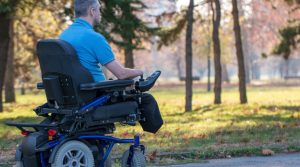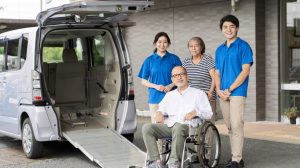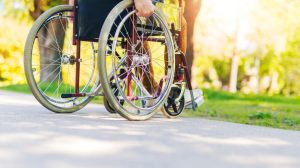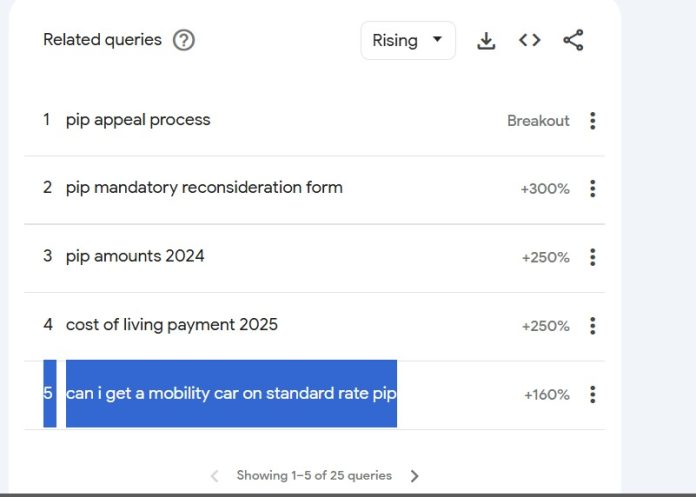Table of Contents
Personal Independence Payment (PIP) is a government benefit designed to help people with disabilities or long-term health conditions manage their daily lives and mobility needs.
One of the most well-known support options available for those receiving PIP is the Motability Scheme, which allows eligible individuals to lease a car using their mobility allowance.
However, many people wonder whether they can get a Motability car on the standard rate of PIP or if the scheme is only available for those receiving the enhanced rate. In this guide, I’ll explain how the scheme works, the eligibility criteria, and what alternatives are available if you don’t qualify.
What Is Personal Independence Payment (PIP)?

Personal Independence Payment (PIP) is a UK government benefit designed to help individuals who have a disability or long-term health condition that affects their daily life and mobility.
Unlike other disability benefits, PIP is not based on income or savings but rather on how the condition impacts a person’s ability to perform everyday tasks and move around.
The Department for Work and Pensions (DWP) assesses PIP applicants through a points-based system that evaluates how difficult certain activities are for them.
These activities include preparing food, managing medication, dressing, washing, and moving around outside the home. Depending on the level of difficulty an applicant faces, they may qualify for either the standard or enhanced rate of PIP.
PIP consists of two components:
- Daily Living Component: Awarded to individuals who need help with routine tasks such as personal care, communication, and decision-making.
- Mobility Component: Given to those who have difficulty getting around due to a physical or cognitive disability.
Each component is further divided into two payment levels, depending on the severity of the individual’s condition.
What Are the Rates of PIP?
The amount a person receives from PIP depends on their assessment outcome. As of 2024, the weekly rates for PIP are as follows:
| PIP Component | Standard Rate | Enhanced Rate |
| Daily Living Component | £68.10 | £101.75 |
| Mobility Component | £26.90 | £71.00 |
The mobility component is particularly important for individuals who are interested in the Motability Scheme, as eligibility for the scheme is dependent on receiving the enhanced rate of the mobility component.
How Does the Motability Scheme Work?
The Motability Scheme is a UK-based initiative that provides disabled individuals with access to a car, powered wheelchair, or scooter through a lease agreement.
The scheme is run by the charity Motability and is designed to help people remain independent by allowing them to use their mobility allowance to cover the cost of a vehicle.
When an individual joins the Motability Scheme, their qualifying benefit is paid directly to Motability every four weeks.
This ensures that the cost of leasing the vehicle is covered without the need for additional personal payments, except in cases where a more expensive car requires an upfront payment.
The scheme provides a fully insured and maintained vehicle for a three-year lease period. At the end of this period, the individual can either extend the lease or exchange the vehicle for a new one.
What Does the Motability Scheme Provide?
The Motability Scheme offers more than just access to a vehicle. It includes several benefits designed to make driving as convenient and worry-free as possible.
- Fully comprehensive insurance: This covers accidental damage, fire, theft, and vandalism. The policy also allows for up to three named drivers, so the individual does not necessarily have to drive the vehicle themselves.
- Road tax: The scheme takes care of all vehicle tax payments, ensuring the car remains legally on the road.
- Breakdown assistance: Full breakdown cover is included, ensuring that users receive assistance if they experience a vehicle failure.
- Vehicle servicing and maintenance: Regular servicing and any necessary repairs are covered by the scheme.
- Tyre and windscreen replacement: If a tyre is punctured or a windscreen is damaged, the cost of replacement is included.
- Adaptations: If an individual requires modifications to the vehicle for accessibility, the scheme covers many of these at no extra cost.
These benefits make the scheme an attractive option for those who qualify, as it removes many of the financial and practical burdens associated with owning a vehicle.
Can I Get a Mobility Car on Standard Rate PIP in the UK?

Receiving the standard rate of PIP mobility does not make an individual eligible for the Motability Scheme. The scheme is only available to those receiving the enhanced rate of the mobility component.
To be eligible, an individual must be receiving one of the following allowances with at least 12 months remaining on the award:
- Enhanced Rate of the Mobility Component of PIP
- Higher Rate Mobility Component of Disability Living Allowance (DLA)
- Enhanced Rate of the Mobility Component of Adult Disability Payment (Scotland)
- Higher Rate Mobility Component of Child Disability Payment (Scotland)
- War Pensioners’ Mobility Supplement (WPMS)
- Armed Forces Independence Payment (AFIP)
If an individual is only awarded the standard rate of PIP mobility, they do not meet the criteria for the scheme and will need to explore alternative mobility solutions.
What Are the Alternatives If I Do Not Qualify?

For individuals who do not qualify for the Motability Scheme, there are still several other ways to maintain mobility and access suitable transport. While the scheme provides a structured and convenient way to lease a vehicle, there are alternative mobility aids, car finance options, government support programs, and charitable initiatives that can help.
1. Other Mobility Aids
If a car is not an option, individuals with mobility challenges can consider alternative aids to assist with movement and daily activities.
- Manual wheelchairs – A cost-effective and widely available option for those who require mobility support for short distances. Some charities and NHS services provide wheelchairs free of charge or on a long-term loan basis.
- Electric wheelchairs and power chairs – These provide greater independence and require less physical effort compared to manual wheelchairs. Some models are lightweight and foldable for easy transport.
- Mobility scooters – Available in different sizes and models, mobility scooters can be a great alternative to a car for local trips such as shopping, visiting friends, or running errands. Some local councils provide grants or financial assistance to help with purchasing a scooter.
2. Car Finance and Leasing Options
Although the Motability Scheme is an excellent way to lease a vehicle, those who are not eligible can still explore private car financing and leasing options.
- Personal Contract Purchase (PCP): This option allows individuals to lease a car with fixed monthly payments. At the end of the agreement, they can either return the vehicle, pay a final lump sum to own it, or exchange it for a newer model.
- Hire Purchase (HP): This financing method involves paying monthly instalments until the vehicle is fully paid off. The car becomes the owner’s property at the end of the contract.
- Standard Car Leasing: Many car dealerships offer leasing plans that function similarly to the Motability Scheme. These agreements typically include insurance and maintenance options but require a credit check.
- Second-Hand Accessible Vehicles: For those who need a vehicle with modifications (such as wheelchair ramps or hand controls), buying a second-hand adapted vehicle can be a more affordable alternative to leasing a new one. Some charities and organisations specialise in selling or financing pre-adapted mobility vehicles.
3. Government and Charity Support
For those who need financial assistance with transport but do not qualify for the Motability Scheme, several government programs and charities offer alternative support.
- Local Council Transport Assistance: Some UK councils provide door-to-door transport services for disabled individuals, such as Dial-a-Ride, community transport schemes, or subsidised taxi fares.
- Blue Badge Scheme: While this does not provide a vehicle, a Blue Badge allows disabled drivers or passengers to park in designated accessible spaces, park on double yellow lines (where permitted), and receive free or discounted parking in some locations.
- Access to Work Scheme: This UK government program offers financial support for work-related transport costs, such as taxi fares or adapted vehicles, for those with a disability.
- Charitable Grants: Some UK charities provide funding to help disabled individuals purchase a mobility aid or adapted vehicle. Examples include Turn2Us, Family Fund, and The Mobility Trust.
4. Public Transport Discounts and Accessibility Services
If a personal vehicle is not a viable option, public transport can still be an accessible and affordable alternative. Many public transport services in the UK offer discounts, concessions, and accessibility support for disabled individuals.
- Disabled Person’s Railcard: Provides a one-third discount on train fares for disabled passengers and their companions.
- Bus Pass for Disabled People: Many local councils offer free or discounted bus travel for individuals with disabilities.
- Taxi Discount Schemes: Some councils operate subsidised taxi schemes, offering discounts on fares for disabled passengers.
- Community Transport Services: Various charities and organisations provide accessible minibus services for those who cannot use conventional public transport.
5. Car Sharing and Volunteer Driver Schemes
For those who do not own a vehicle but still need access to transport, car-sharing and volunteer driver schemes can provide a flexible alternative.
- Lift-Share and Community Transport Schemes: Some areas offer car-sharing services where individuals can travel together, reducing transport costs. Websites such as Liftshare and BlaBlaCar allow people to find shared rides to their destinations.
- Volunteer Driver Programs: Some charities and community groups run volunteer driver services where individuals can book rides with trained volunteer drivers who provide transport at a low cost or for free. This service is particularly useful for medical appointments, shopping trips, and social outings.
- Social Car Schemes: Some non-profit organisations and councils run low-cost, accessible car hire schemes that allow disabled individuals to rent vehicles on a short-term basis.
6. Cycling and Mobility Scooters for Short-Distance Travel
For individuals who do not require a car but still need a personal mode of transport, electric bicycles, adaptive tricycles, and advanced mobility scooters can be a great alternative.
- Adaptive Bicycles and Tricycles: Specially designed adaptive bicycles are available for individuals with balance issues, physical impairments, or coordination difficulties. Some models include electric assistance to reduce physical effort.
- Road-Legal Mobility Scooters: Some Class 3 mobility scooters are legally allowed on roads and can travel up to 8 mph, making them a viable alternative for people who need to cover longer distances.
These solutions provide affordable, environmentally friendly, and practical alternatives to a car for many disabled individuals.
By exploring these alternatives, individuals who do not qualify for the Motability Scheme can still find practical, cost-effective ways to improve their mobility and maintain independence.
How Can I Apply for the Motability Scheme?

For individuals who meet the eligibility requirements, applying for the Motability Scheme is a straightforward process.
- Check eligibility: The first step is to confirm that the individual is receiving a qualifying benefit and has at least 12 months remaining on their award.
- Choose a vehicle: The individual can select a vehicle from a Motability-approved dealership based on their needs and preferences.
- Find a Motability dealer: Visiting a dealer allows applicants to explore their options and receive advice on suitable vehicles.
- Place an order: Once a vehicle is selected, the order can be placed through the dealership. The lease agreement is signed, and adaptations can be requested if necessary.
- Payments and delivery: The mobility allowance is then paid directly to Motability each month, and the vehicle is delivered for use.
Once the lease begins, the individual benefits from all the services included in the scheme, ensuring a stress-free driving experience.
What Are the Benefits of Using the Motability Scheme?
For those who qualify, the Motability Scheme offers significant advantages. It provides cost savings, convenience, and accessibility, allowing individuals to maintain independence without worrying about unexpected expenses.
The comprehensive insurance and servicing packages ensure that users are fully covered, while the ability to upgrade vehicles every three years means they always have access to a reliable and suitable mode of transport.
For individuals who do not qualify, alternative mobility aids, car financing options, and charitable support remain viable options to ensure continued independence and mobility.
Conclusion
If you receive the standard rate of PIP mobility, you are unfortunately not eligible for the Motability Scheme. However, there are still many options available, including alternative mobility aids, car finance plans, and charity support to help you stay mobile.
If you receive the enhanced rate of PIP mobility, applying for a Motability car is a great way to ensure hassle-free, accessible transport with minimal financial burden.
For more details, visit the official Motability website or speak to a disability support organisation for personalised advice.
FAQs
What is the difference between standard and enhanced rate PIP mobility?
The standard rate is for those who have some difficulty walking, while the enhanced rate is for those who have severe mobility issues or cannot walk without assistance.
Can I use my PIP money to lease a car without the Motability Scheme?
Yes, you can use your PIP payments independently to finance or lease a car, but you’ll need to cover insurance and maintenance costs yourself.
Are there any discounts for disabled drivers who don’t qualify for Motability?
Some car manufacturers and dealerships offer discounts for disabled drivers.
Can family members drive my Motability car for me?
Yes, up to three named drivers can be included on the insurance.


